Lyons W.C. (ed.). Standard handbook of petroleum and natural gas engineering.2001- Volume 1
Подождите немного. Документ загружается.

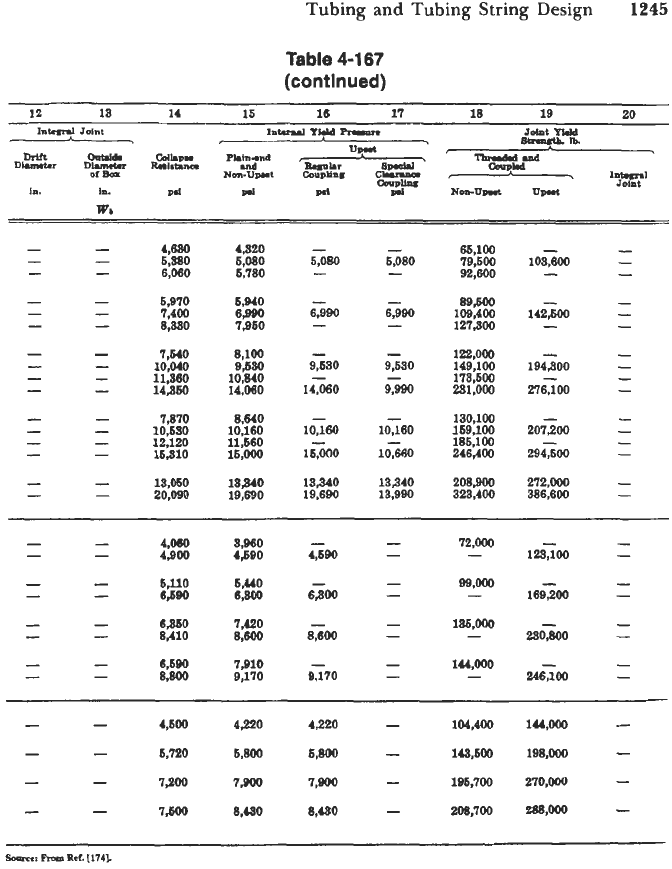
Tubing and Tubing String Design
1245
(contlnued)
12
13 14 15 16 17 18 19
20
-
-
7,540
8,100
- -
122,000
-
-
9,630 149,100 194,300
-
-
178,600
-
-
- -
10,040 9,680 9,630
-
-
11,360 10,840
-
- -
14860 14.060 14,060 9,990 231,000 276,100
-
-
-
7,870
8,640
-
-
130,100
-
-
- -
10,650
10.160 10,160
10,160
169,100
207,200
-
- -
12.120
11,660
-
-
185.100
-
-
-
-
-
16,SlO 16,000 15,000 10,660 246,400 294,600
- -
13.060
18,846
18,340
13,340
208.900
272,000
-
- -
20,090
19,690 19.680
13,990
823,400 386,600
-
-
-
6,690
7,910
-
-
114,000
-
-
-
-
8,800
9,170
9,170
- -
246,100
-
~ ~~ ~ ~~
-
-
4,600
4,220
4,220
-
104,400 114,OOO
-
-
-
6,720
6,800
5,800
-
143,600 198,000
-
-
-
7300
7,900
7.900
-
196,700
270,000
-
-
-
7mO
8,430 8,430
-
208,700
zeS.000
-
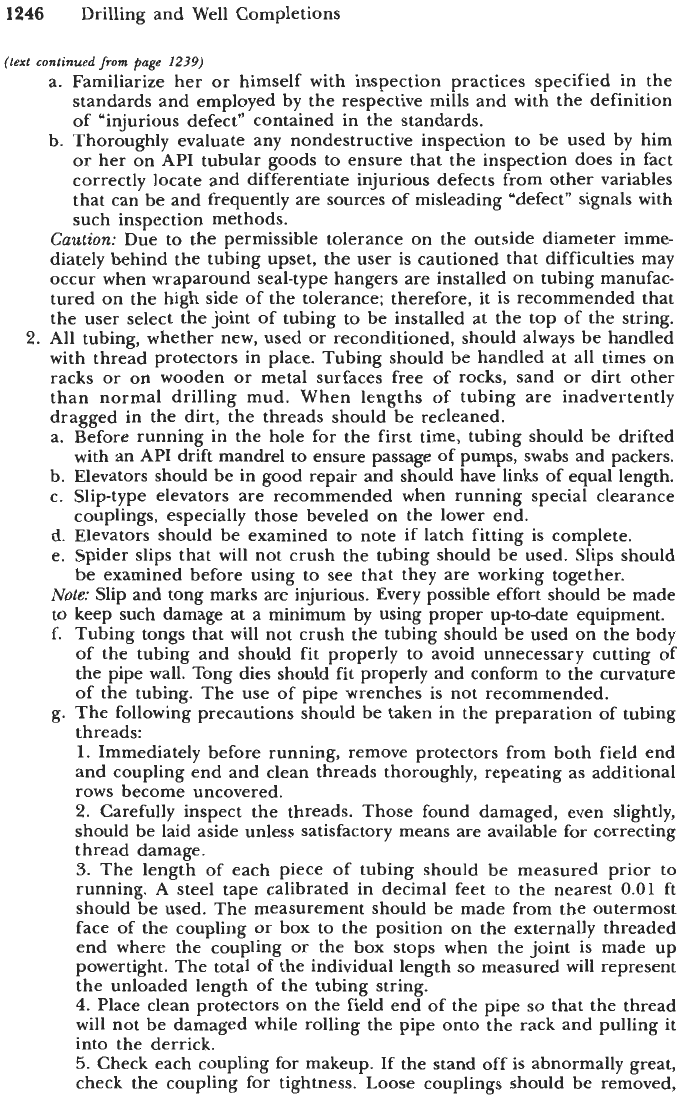
1246
Drilling and Well Completions
(text
continued
from
page
1239)
a. Familiarize her or himself with inspection practices specified in the
standards and employed by the respective mills and with the definition
of “injurious defect” contained in the standards.
b. Thoroughly evaluate any nondestructive inspection to be used by him
or her on API tubular goods to ensure that the inspection does in fact
correctly locate and differentiate injurious defects from other variables
that can be and frequently are sources of misleading “defect” signals with
such inspection methods.
Caution:
Due to the permissible tolerance on the outside diameter imme-
diately behind the tubing upset, the user is cautioned that difficulties may
occur when wraparound seal-type hangers are installed on tubing manufac-
tured on the high side of the tolerance; therefore, it is recommended that
the user select the joint of tubing to be installed at the top of the string.
2.
All tubing, whether new, used or reconditioned, should always be handled
with thread protectors in place. Tubing should be handled at all times on
racks or on wooden or metal surfaces free of rocks, sand or dirt other
than normal drilling mud. When lengths of tubing are inadvertently
dragged in the dirt, the threads should be recleaned.
a. Before running in the hole for the first time, tubing should be drifted
with an API drift mandrel to ensure passage of pumps, swabs and packers.
b. Elevators should be in good repair and should have links of equal length.
c. Slip-type elevators are recommended when running special clearance
d. Elevators should be examined to note if latch fitting is complete.
e. Spider slips that will not crush the tubing should be used. Slips should
Note:
Slip and tong marks are injurious. Every possible effort should be made
to keep such damage at a minimum by using proper up-todate equipment.
f.
Tubing tongs that will not crush the tubing should be used on the body
of the tubing and should fit properly to avoid unnecessary cutting
of
the pipe wall. Tong dies should fit properly and conform to the curvature
of the tubing. The use of pipe wrenches is not recommended.
g.
The following precautions should be taken in the preparation of tubing
threads:
1.
Immediately before running, remove protectors from both field end
and coupling end and clean threads thoroughly, repeating as additional
rows become uncovered.
2.
Carefully inspect the threads. Those found damaged, even slightly,
should be laid aside unless satisfactory means are available for correcting
thread damage.
3.
The length of each piece
of
tubing should be measured prior to
running. A steel tape calibrated in decimal feet to the nearest
0.01
ft
should be used. The measurement should be made from the outermost
face of the coupling or box to the position on the externally threaded
end where the coupling or the box stops when the joint is made up
powertight. The total of the individual length
so
measured will represent
the unloaded length of the tubing string.
4.
Place clean protectors on the field end of the pipe
so
that the thread
will not be damaged while rolling the pipe onto the rack and pulling it
into the derrick.
5.
Check each coupling for makeup. If the stand off is abnormally great,
check the coupling for tightness. Loose couplings should be removed,
couplings, especially those beveled on the lower end.
be examined before using to see that they are working together.
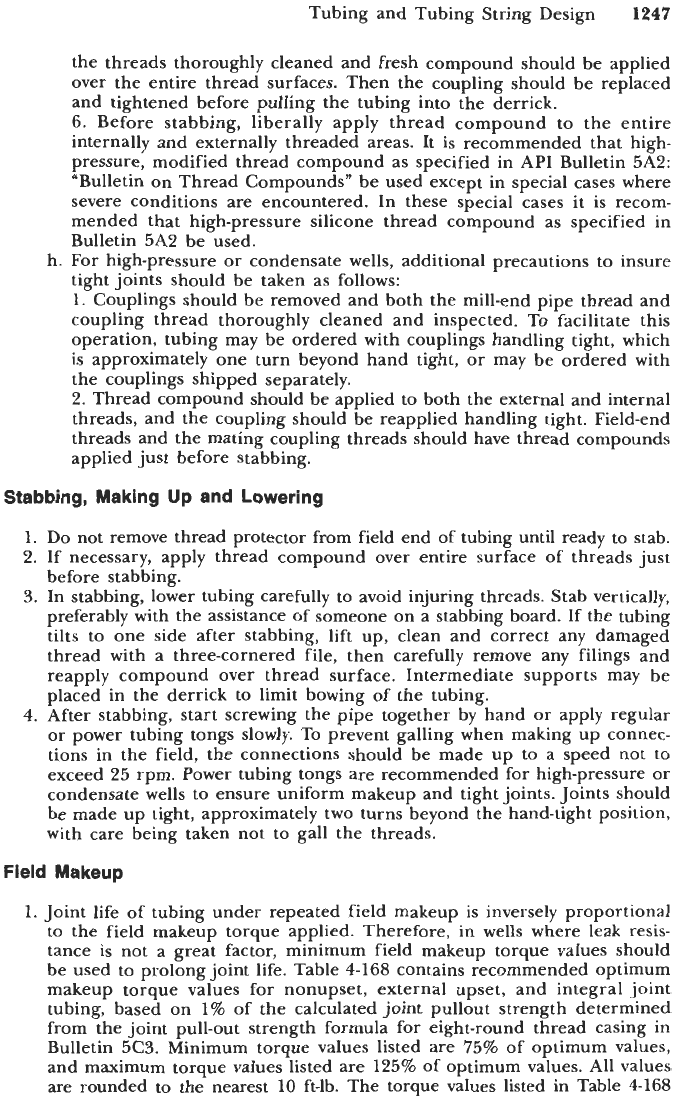
Tubing and Tubing String Design
1247
the threads thoroughly cleaned and fresh compound should be applied
over the entire thread surfaces. Then the coupling should be replaced
and tightened before pulling the tubing into the derrick.
6. Before stabbing, liberally apply thread compound to the entire
internally and externally threaded areas. It is recommended that high-
pressure, modified thread compound as specified in API Bulletin
5A2:
“Bulletin on Thread Compounds” be used except in special cases where
severe conditions are encountered. In these special cases it is recom-
mended that high-pressure silicone thread compound as specified in
Bulletin
5A2
be used.
h.
For
high-pressure or condensate wells, additional precautions to insure
tight joints should be taken as follows:
1.
Couplings should be removed and both the mill-end pipe thread and
coupling thread thoroughly cleaned and inspected. To facilitate this
operation, tubing may be ordered with couplings handling tight, which
is approximately one turn beyond hand tight,
or
may be ordered with
the couplings shipped separately.
2.
Thread compound should be applied to both the external and internal
threads, and the coupling should be reapplied handling tight. Field-end
threads and the mating coupling threads should have thread compounds
applied just before stabbing.
Stabbing, Making Up and Lowering
1.
Do not remove thread protector fmm field end of tubing until ready to stab.
2.
If necessary, apply thread compound over entire surface of threads just
before stabbing.
3.
In stabbing, lower tubing carefully to avoid injuring threads. Stab vertically,
preferably with the assistance of someone on a stabbing board. If the tubing
tilts to one side after stabbing, lift up, clean and correct any damaged
thread with a three-cornered file, then carefully remove any filings and
reapply compound over thread surface. Intermediate supports may be
placed in the derrick to limit bowing of the tubing.
4. After stabbing, start screwing the pipe together by hand or apply regular
or power tubing tongs slowly. To prevent galling when making up connec-
tions in the field, the connections should be made up to a speed not to
exceed
25
rpm. Power tubing tongs are recommended for high-pressure or
condensate wells to ensure uniform makeup and tight joints. Joints should
be made up tight, approximately two turns beyond the hand-tight position,
with care being taken not to gall the threads.
Field Makeup
1.
Joint life of tubing under repeated field makeup is inversely proportional
to the field makeup torque applied. Therefore, in wells where leak resis-
tance is not a great factor, minimum field makeup torque values should
be used to prolong joint life. Table 4-168 contains recommended optimum
makeup torque values for nonupset, external upset, and integral joint
tubing, based on 1% of the calculated joint pullout strength determined
from the joint pull-out strength formula for eight-round thread casing in
Bulletin
5C3.
Minimum torque values listed are
75%
of optimum values,
and maximum torque values listed are
125%
of optimum values.
All
values
are rounded to the nearest 10 ft-lb. The torque values listed in Table 4-168

1248
Drilling and Well Completions
Table
4-168
Recommended Tubing Makeup Torque
1
23 4 6 6 7
8
9 10 11 12 18 14
Na4h.I
wd.ht
To-.
it-lb
81":
Ibmrrt.
oaldlk
in.
In&
Joint
.--
NOn-Uprt
U*
D-
'
Tbdmd
c-mnr
'YE?'
ad
I
g%i
uprt
Opb
Mln.
Mu.
0r.t
We
Mu.
Opt.
Yln.
Max.
1.050 1.14 110
-
H-40
140 110 180 460 360 680
-
-
-
1.14 110
-
5-66
180 140 230 600 460 760
-
-
-
1.14 1.20
-
C76 230 170 290 780
690
980
-
-
-
1.14 1.20
-
LBO
240
180
300 810 610 1010
-
-
-
1.14 110
-
N-80 260 190 310 830 620 1040
-
-
-
1.316 1.70
1.70
1.70
1.70
1.70
1.660
-
230
2.80
2.30
2.30
2.30
-
1.80 1.72
H-IO
1.80
1.72
5-65
1.80 1.12
C75
1.80 1.72
L-80
1.30
1.72 N-80
-
2.10
H-40
2.40
2.38
H-40
-
2.10
5-66
2.40
2.38
5-65
2.40
2.33 C76
2.40 2.53 L-80
2.40
2.33 N-80
210
270
360
370
880
-
-
270
360
460
470
490
-
160
200
270
280
290
-
200
260
a60
350
370
-
260
340
460
460
480
-
-
340
-
440
680
690
610
440
670
740
760
790
-
630
690
910
940
960
-
330
430
660
670
690
-
-
400
620
680
710
720
-
660
710
930
960
990
-
660
860
1140
1180
1200
-
310
400
620
540
660
380
380
500
500
660
670
690
-
230
300
390
400
410
280
280
880
880
490
600
620
390
600
650
680
690
480
480
6%'
680
810
850
860
1.900
-
-
2.40
HA0
- -
-
-
-
-
460
340
660
2.76 2.90 2.76
H-40
320 240 400 670 500
840
460 340 660
680
440
730
-
-
2.40
5-65
-
- -
-
-
-
2.76
2.90 2.76
5-66
410 310 510
880
660
1100 580
440 730
2.76
2.90 2.76
C-76
540
410
680
1160 860 1440 760
670 950
2.76
2.90 2.76
LBO
560
420
700 1190 890 1490
790
690
990
2.76
2.90 2.76
N-80
670
430
710 1220
920 1630
810
610 1010
apply only to tubing with zinc-plated couplings. When making up connec-
tions with tin-plated couplings,
80%
of the listed value can be used as a guide.
2.
Spider slips and elevators should be cleaned frequently, and slips should
be kept sharp.
3.
Finding bottom should be accomplished with extreme caution.
Do
not set
tubing down heavily.
Pulling Tublng
1.
A
caliper survey prior to pulling a worn string of tubing will provide a
quick means of segregating badly worn lengths for removal.
2.
Break-out tongs should be positioned close to the coupling. Hammering
the coupling to break the joint is an injurious practice.
3.
Great care should be exercised to disengage all of the thread before lifting
the tubing out of the coupling. Do not jump the tubing out of the coupling.
4.
Tubing stacked in the derrick should be set on a firm wooden platform
without the bottom thread protector since the design of most protectors is
not such as to support the joint or stand without damage to the field thread.
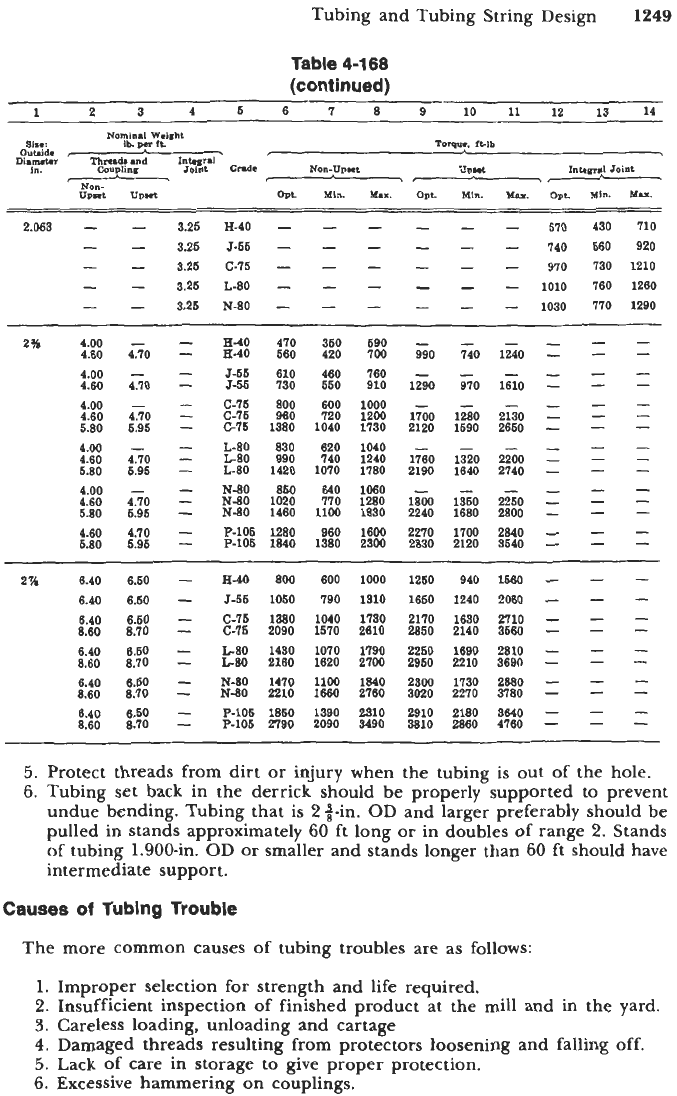
Tubing and Tubing String Design
1249
Table
4-1
68
(continued)
1 23 4 5 6 7 8 9 10
11
12 13 14
~~
2.063
-
-
3.25 H-40
-
-
- -
-
-
570 430 710
740 660 920
- -
3.25 C-75
- -
-
-
-
-
970 730 1210
--
3.26
L-80
-
-
-
-
-
-
1010 760 1260
-
-
3.25
N-80
-
-
-
-
-
-
1030
770 1290
-
-
3.25 J-55
-
-
-
-
-
-
2% 4.00
- -
H-40 470 360 590
-
-
-
-
-
-
4.60 4.70
-
E-40 660 420 700 990 740 1240
- -
-
4.00
-
-
5-65
610
460
760
-
-
-
-
-
-
4.60
4.70
-
J-55
730
560 910
1290
970
1610
-
-
-
4.00
-
-
C-75
800
600
1000
-
-
-
-
-
-
4.60
4.70
-
C-75
960
720
1200 1700 1280
2130
-
- -
5.80
5.95
-
C-75
1380 1040
1730 2120 1590
2650
-
- -
L-80 830 620 1040
-
-
-
-
- -
4.00
- -
4.60 4.70
-
L-80 990 740 1240 1760 1320 2200
-
-
-
5.80 5.95
-
L-80 1420 1070 1780 2190 1640 2740
-
- -
4.00
-
-
N-80
860
640
1060
-
-
-
-
-
-
4.60
4.70
-
N-80
1020 770 1280
1800
1350
2250
-
-
-
5.80
5.95
-
N-80
1460
1100
1830
2240
1680
2800
-
-
-
4.60
4.70
-
P-106
1280 960
1600
2270
1700
2840
-
-
-
5.80
5.95
-
P-105
1840 1380
2300 2830
2120
3540
-
-
-
2% 6.40 6.50
-
H-40
800 600
1000
1250 940 1560
-
-
-
6.40 6.50
-
5-55 1050 790 1310 1650 1240 2060
- -
-
6.40
6.60
-
C-75 I380 1040 1730
2170 1630
2710
-
- -
8.60
8.70
-
C-75
2090 1570
2610
2860
2140
3660
-
-
-
6.40
6.50
-
L-80
1430 1070 1790
2260
1690
2810
-
-
-
8.60
8.70
-
LBO
2160
1620 2700
2960
2210
3680
-
-
-
6.40
6.50
-
N-80
1470 1100
1840
2300
1730
2880
-
-
-
8.60
8.70
-
N-80
2210 1660
2760 3020
2270
3780
-
- -
6.40
6.50
-
P-106
1860 1390
2910
2910
2180
3640
-
-
-
8.60
8.70
-
P-105
2190
2090
3490 3810
2860
4760
-
-
-
5.
Protect threads from dirt
or
injury when the tubing is out
of
the hole.
6.
Tubing set back in the derrick should be properly supported to prevent
undue bending. Tubing that is 24-in.
OD
and larger preferably should be
pulled in stands approximately
60
ft long
or
in doubles of range 2. Stands
of tubing 1.900-in.
OD
or
smaller and stands longer than
60
ft
should have
intermediate support.
Causes
of
Tubing Trouble
The more common causes of tubing troubles are as follows:
1.
Improper selection for strength and life required.
2.
Insufficient inspection of finished product at the mill and in the yard.
3.
Careless loading, unloading and cartage
4.
Damaged threads resulting
from
protectors loosening and falling
off.
5.
Lack of care in storage to give proper protection.
6.
Excessive hammering on couplings.
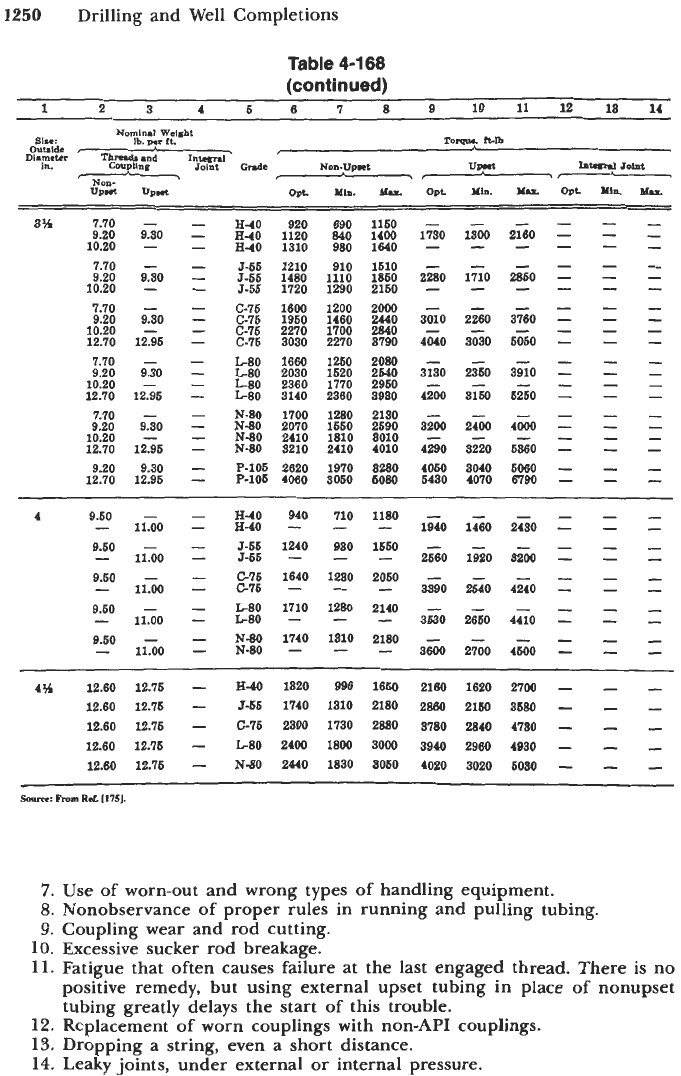
1250
Drilling and Well Completions
Table
4-1
68
(continued)
1
23 4
6
6
7
8 9 10 11 12 13 14
TO-
n&
Nominal Weight
Si-:
Ib.
mr
it.
Outside
I.-
Joint
r
-A-
Nan-Uprt
Diameter
'
Thm
snd
In-I
'
in.
cm.unp
Joint
Cdc
mt.
xin.
yu.
OPL
xin.
mu.
WL
mi-
x-
woo-
UP&
UP&
---
3%
7.70
- -
H-40
920 690 1150
-
9.20 9.30
-
H-40
1120 840 1400
1730
1% 2ZO
- -
-
10.20
-
-
H-40
1310 980 1640
- - -
-
- -
J-55
1210 910 1610
-----
7.70
-
-
9.20 9.30
-
J-55
1480 1110 1860 2280 1710
2850
-
-
-
10.20
- -
J-55
1720 1290 2160
-
- - - - -
7.70
- -
C-75
1600 1200
ZOO0
9.20
9.30
-
C-75
1950 1460 2440
3%0 2260
350
-
-
-
12.70
12.96
-
(3-76
3030 2270
3790
4&
3ZO
6060
-
-
-
7.70
-
-
LBO
1660
1250
2080
-
-
-
-
- -
9.20 9.30
-
LBO
2030 1520
2540
3130 2350 3910
- -
-
10.20
-
-
dB0 2360
1770
2950
-
---
12.70 12.95
-
L-80
3140 2360 3980 4200 3160
6ZO
-
-
-
N-80
1700
1280 2130
----
7.70
-
-
9.20
3.30
-
N-80
2070
1550 2590
3&
2z 4000
- - -
10.20
-
-
N-80 2410 1810
8010
-
---
12.70
12.95
-
N-80
3210 2410
4010 4290
SSO
6860
-
-
-
9.20
9.30
-
P-106 2620 1970
8280
4050
SO40
5060
-
-
-
12.70
12.96
-
P-105 4060
3060
6080 6430 4070
6790
-
-
-
---
10.20
- -
C-75
2270 1700 2840
---
4 9.50
-
H-40
940 710 1180
---
-
1100
-
H-40
- - -
1z lZ0 2zo
- -
-
9.60
-
-
J-66
1240 980 1650
- - -
-
- -
-
11.00
-
J-66
- - -
2660 1920 3200
- -
-
9.60
-
-
C-76
1640 1230 2060
-
-
-
-
-
-
-
11.00
-
C76
- -
-
3590
2640
4240
-
-
-
9.50
-
-
LBO
1710 1280 2140
- -
-
-
-
-
-
11.00
-
LSO
-
-
-
3530
2650 4410
- -
-
9.50
- -
N-80 1740 1810 2180
-
- - -
- -
3600 2700 4500
- -
-
-
11.00
-
N-80
-
-
-
4% 12.60 12.76
-
H-40
1820
990
1660 2160 1620 2700
- - -
12.60 12.75
-
J-65
1740 1310 2180 2860 2160 3680
-
-
-
12.60
12.76
-
C-75
2800 1730 2880 3780
2840
4780
-
- -
12.60 12.76
-
LBO
2400 1800
3000
3940 2960 4930
-
-
-
12.60 12.75
-
N-80
2440 1830 3060 4020 3020
5030
- - -
-
Soarm
Fmm
Rd
I1751.
7.
Use
of
worn-out and wrong types
of
handling equipment.
8.
Nonobservance
of
proper rules in running and pulling tubing.
9.
Coupling wear and rod cutting.
10.
Excessive sucker rod breakage.
11.
Fatigue that often causes failure at the last engaged thread. There is no
positive remedy, but using external upset tubing in place
of
nonupset
tubing greatly delays the start
of
this trouble.
12.
Replacement
of
worn couplings with non-API couplings.
13.
Dropping a string, even a short distance.
14.
Leaky joints, under external
or
internal pressure.
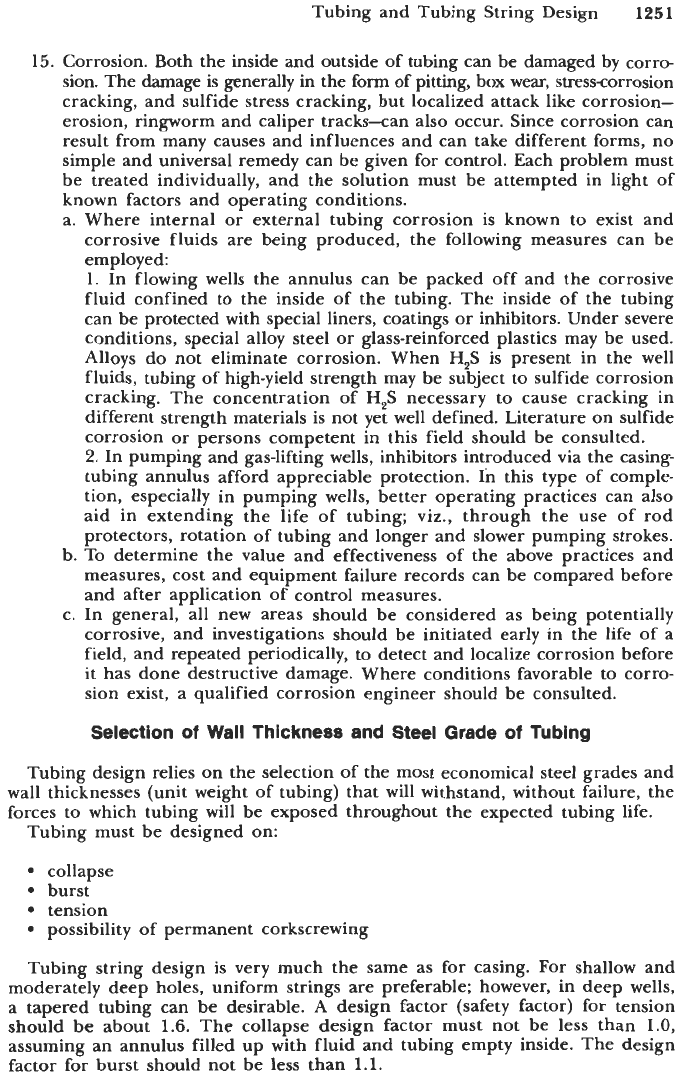
Tubing and Tubing String Design
1251
15.
Corrosion. Both the inside and outside of tubing can be damaged by corro-
sion. The damage is generally in the form of pitting, box wear, stresscorrosion
cracking, and sulfide stress cracking, but localized attack like corrosion-
erosion, ringworm and caliper tracks-can also occur. Since corrosion can
result from many causes and influences and can take different forms, no
simple and universal remedy can be given for control. Each problem must
be treated individually, and the solution must be attempted in light of
known factors and operating conditions.
a. Where internal or external tubing corrosion
is
known
to
exist and
corrosive fluids are being produced, the following measures can be
employed:
1.
In flowing wells the annulus can be packed off and the corrosive
fluid confined to the inside of the tubing. The inside of the tubing
can be protected with special liners, coatings or inhibitors. Under severe
conditions, special alloy steel or glass-reinforced plastics may be used.
Alloys do not eliminate corrosion. When
H,S
is present in the well
fluids, tubing of high-yield strength may be subject to sulfide corrosion
cracking. The concentration of
H,S
necessary to cause cracking in
different strength materials is not yet well defined. Literature on sulfide
corrosion or persons competent in this field should be consulted.
2.
In pumping and gas-lifting wells, inhibitors introduced via the casing-
tubing annulus afford appreciable protection.
In
this type of comple-
tion, especially in pumping wells, better operating practices can also
aid in extending the life of tubing; viz., through the use of rod
protectors, rotation of tubing and longer and slower pumping strokes.
b. To determine the value and effectiveness of the above practices and
measures, cost and equipment failure records can be compared before
and after application of control measures.
c. In general, all new areas should be considered as being potentially
corrosive, and investigations should be initiated early in the life of a
field, and repeated periodically,
to
detect and localize corrosion before
it has done destructive damage. Where conditions favorable to corro-
sion exist, a qualified corrosion engineer should be consulted.
Selection
of
Wall Thickness and Steel Grade of Tubing
Tubing design relies on the selection
of
the most economical steel grades and
wall thicknesses (unit weight of tubing) that will withstand, without failure, the
forces to which tubing will be exposed throughout the expected tubing life.
Tubing must be designed on:
collapse
burst
tension
possibility
of
permanent corkscrewing
Tubing string design is very much the same as for casing. For shallow and
moderately deep holes, uniform strings are preferable; however, in deep wells,
a tapered tubing can be desirable.
A
design factor (safety factor) for tension
should be about
1.6.
The collapse design factor must not be less than
1.0,
assuming an annulus filled up with fluid and tubing empty inside. The design
factor for burst should not be less than
1.1.
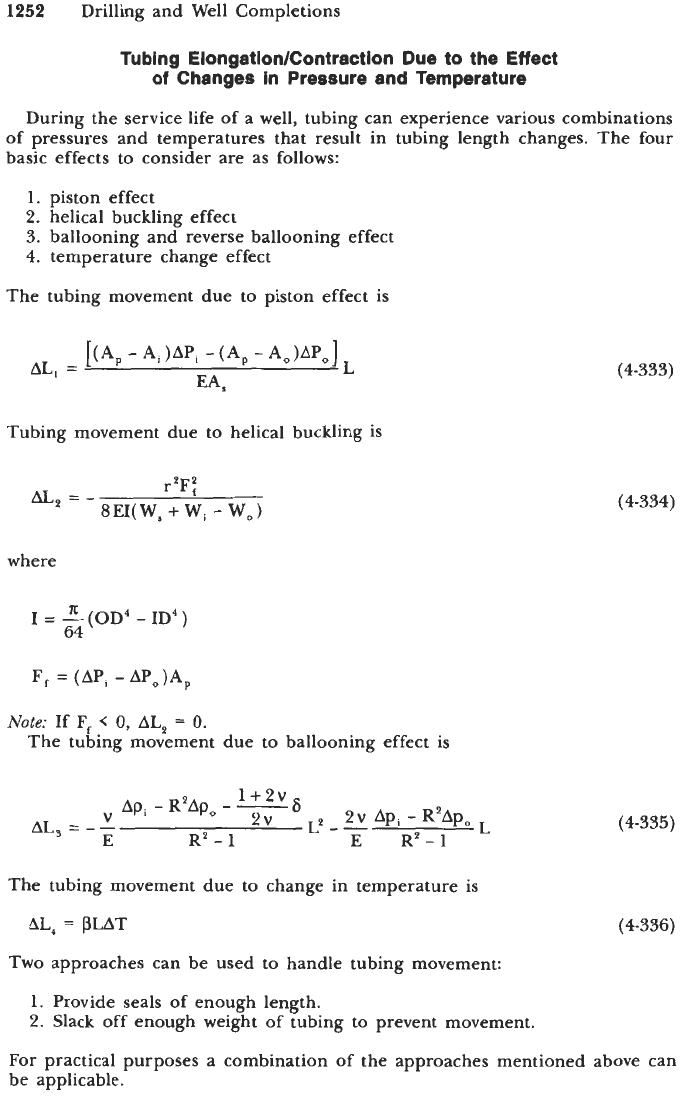
1252
Drilling and Well Completions
Tubing EiongationKontraction Due to the Effect
of
Changes in Pressure and Temperature
During the service life of a well, tubing can experience various combinations
of pressures and temperatures that result in tubing length changes. The four
basic effects to consider are as follows:
1.
piston effect
2. helical buckling effect
3.
ballooning and reverse ballooning effect
4.
temperature change effect
The tubing movement due to piston effect is
Tubing movement due to helical buckling is
rSFi
AL,=-
8EI(W,
+
Wi
-
W,)
where
x
I
=
-(oD~
-ID')
64
F,
=
(APi
-
AP,)A,
Note:
If F,
<
0,
AL2
=
0.
The tubing movement due to ballooning effect is
1+2vg
Api
-
R2Apo
-
-
L
2v
L2--
2v Api
-
R'Ap,
AL3
=
-1
E
R2
-
1
E
R2-1
The tubing movement due to change in temperature is
AL4
=
PLAT
Two approaches can be used to handle tubing movement:
1.
Provide seals of enough length.
2.
Slack off enough weight of tubing to prevent movement.
(4-333)
(4-33.4)
(4-335)
(4-336)
For
practical purposes a combination of the approaches mentioned above can
be applicable.
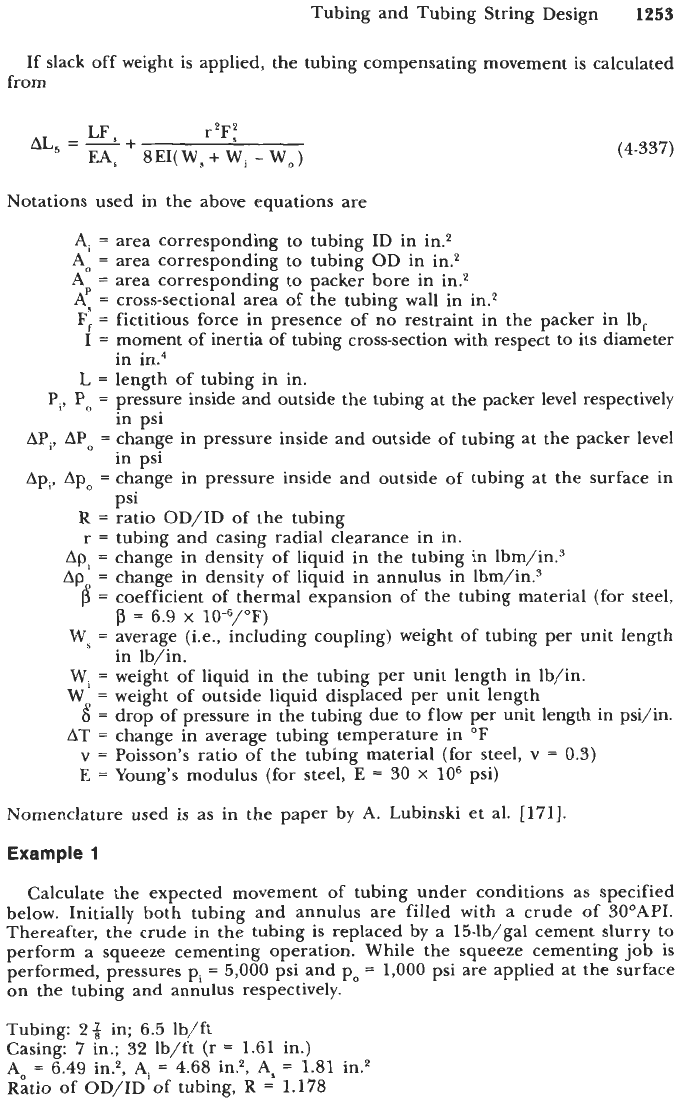
Tubing and Tubing String Design
1253
If slack off weight is applied, the tubing compensating movement is calculated
from
LF
r2Ff
AL5
=
L+
EA,
8EI(W,
+
Wi
-
W,)
(4-337)
Notations used in the above equations are
A,
=
area corresponding to tubing ID in in.'
A.
=
area corresponding to tubing
OD
in in.'
AP
=
area corresponding to packer bore in in.2
As
=
cross-sectional area of the tubing wall in in.2
F,
=
fictitious force in presence of no restraint in the packer in lb,
I
=
moment of inertia of tubing cross-section with respect to its diameter
L
=
length of tubing in in.
in in4
Pt,
Po
=
pressure inside and outside the tubing at the packer level respectively
AP,, APo
=
change in pressure inside and outside
of
tubing at the packer level
Ap,, Apo
=
change in pressure inside and outside
of
tubing at the surface in
in psi
in psi
psi
R
=
ratio OD/ID of the tubing
r
=
tubing and casing radial clearance in in.
Apl
=
change in density of liquid in the tubing in lbm/in.3
Ap
=
change in density of liquid in annulus in lbm/in.3
6
=
coefficient of thermal expansion of the tubing material (for steel,
Ws
=
average (i.e., including coupling) weight of tubing per unit length
Wl
=
weight of liquid in the tubing per unit length in lb/in.
W
=
weight of outside liquid displaced per unit length
AT
=
change in average tubing temperature in
"F
p
=
6.9
x
10-6/oF)
in Ib/in.
6
=
drop of pressure in the tubing due to flow per unit length in psi/in.
v
=
Poisson's ratio of the tubing material (for steel,
v
=
0.3)
E
=
Young's modulus (for steel,
E
=
30
X
lo6
psi)
Nomenclature used is as in the paper by
A.
Lubinski et al.
[171].
Example
1
Calculate the expected movement
of
tubing under conditions as specified
below. Initially both tubing and annulus are filled with a crude of
3O"API.
Thereafter, the crude
in
the tubing
is
replaced by
a
15-lb/gal cement slurry to
perform a squeeze cementing operation. While the squeeze cementing job is
performed, pressures p,
=
5,000
psi and p,
=
1,000
psi are applied at the surface
on the tubing and annulus respectively.
Tubing:
2%
in;
6.5
lb/ft
Casing:
7
in.;
32
lb/ft (r
=
1.61
in.)
A.
=
6.49
in.',
A,
=
4.68 in.2,
As
=
1.81 in.'
Ratio
of
OD/ID
of
tubing,
R
=
1.178

1254
Drilling and Well Completions
AP
=
8.30
in.5
Length of tubing
=
10,000
ft
(120,000
in.)
Average change in temperature:
-20°F
Pressure drop due to flow is disregarded
(6
=
0)
Solution
Pressure changes are the following. At the surface the pressures are Api
=
5,000
psi and Apo
=
1,000
psi. At the packer level,
Ni
=
9,000
psi and APo
=
1,000
psi.
Liquid density changes are Api
=
0.0332
psi/in. and Apo
=
0.0
psi/in. The unit
weight of tubing is
6.5 1.5x4.68 0.876~8.34~6.49
=0.641b/in.
12
23
1
23
1
w
=
w,
+
wi
-
w,
=
-+
The moment of inertia is
I
=
1.61
in.4 The tubing movement due to piston effect is
AL,
=-
120~000[(8.3-4.68)9,000-(8.3-6.49)1,000]
=
-68.0
in.
30 x
lo6
The tubing movement due to buckling effect is
(1.612)X(8.32)(9,000-
1,000)2
=
46.23
in.
AL2
=
8 x 30 x
lo6
x 1.61 x 0.64
The tubing movement due to ballooning effect is
The temperature effect is
AL4
=
-6.9
x
x
120,000
x
20
=
-16.56
in.
The total expected tubing movement is
AL6
=
AL,
+
AL2
+
AL3
+
AL4
=
-165.48
in.
Packer-To-Tubing Force
Certain types of packers permit no tubing motion in either direction. Depend-
ing upon operational conditions, a tubing can be landed either in compression
(slack off) or tension (pull up). Landing tubing in compression is desirable if
the expected tubing movement would produce tubing shortening while landing
in tension to compensate the expected tubing elongation.
